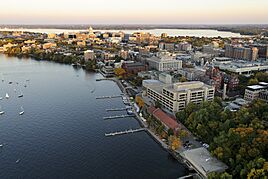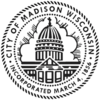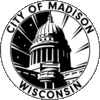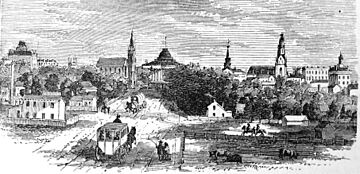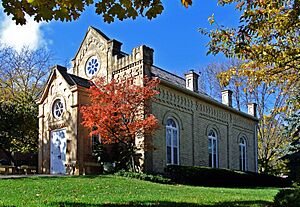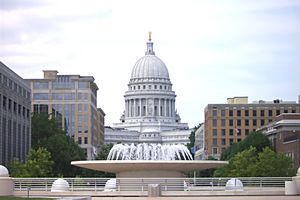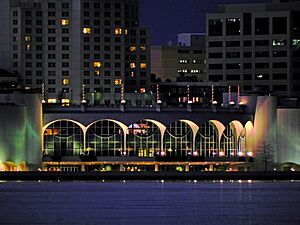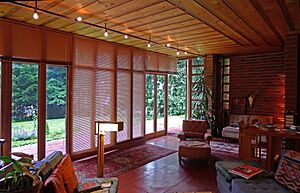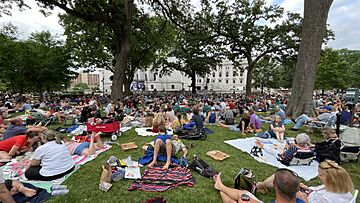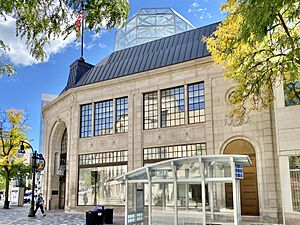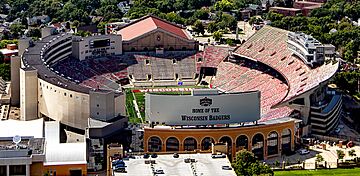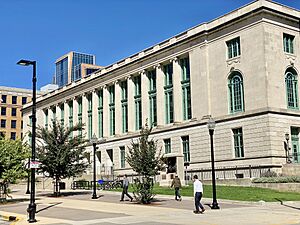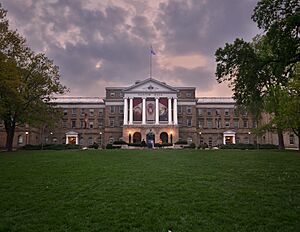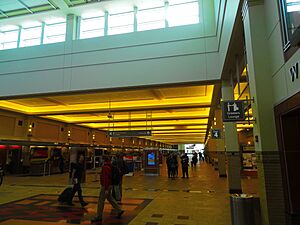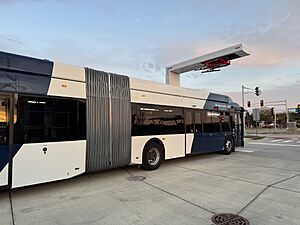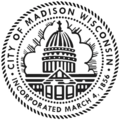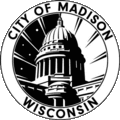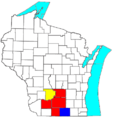Madison, Wisconsin facts for kids
Quick facts for kids
Madison
|
|||||
|---|---|---|---|---|---|
|
|||||
| Nickname(s):
Madtown, Mad City, The City of Four Lakes, 100 Square Miles Surrounded by Reality
|
|||||
| Country | |||||
| State | |||||
| County | Dane | ||||
| Founded | 1836 | ||||
| Incorporated | 1846 (village) 1856 (city) |
||||
| Named for | James Madison | ||||
| Government | |||||
| • Type | Mayor-council | ||||
| Area | |||||
| • City | 101.53 sq mi (262.96 km2) | ||||
| • Land | 79.57 sq mi (206.09 km2) | ||||
| • Water | 21.96 sq mi (56.88 km2) | ||||
| Elevation | 873 ft (266 m) | ||||
| Population
(2020)
|
|||||
| • City | 269,840 | ||||
| • Estimate
(2024)
|
285,300 |
||||
| • Rank | US: 77th WI: 2nd | ||||
| • Density | 3,391/sq mi (1,309/km2) | ||||
| • Urban | 450,305 (US: 89th) | ||||
| • Urban density | 3,008/sq mi (1,161/km2) | ||||
| • Metro | 707,606 (US: 85th) | ||||
| • CSA | 910,246 (US: 61st) | ||||
| • Demonym | Madisonian | ||||
| Time zone | UTC−6 (Central) | ||||
| • Summer (DST) | UTC−5 (CDT) | ||||
| Zip Codes |
ZIP Codes
|
||||
| Area code | 608, 353 | ||||
| FIPS code | 55-48000 | ||||
| GNIS feature ID | 1581834 | ||||
Madison is the capital city of Wisconsin, a state in the United States. It is the second-largest city in Wisconsin. In 2020, about 269,840 people lived there. The larger Madison area has around 708,000 residents.
Madison is special because it sits on a narrow strip of land, called an isthmus, between two large lakes: Lake Mendota and Lake Monona. There are also three other lakes nearby: Lake Wingra, Lake Kegonsa, and Lake Waubesa. The city was founded in 1836 and is named after James Madison, who was the fourth U.S. President. Madison is also the main city for Dane County.
As the state capital, Madison is home to important government buildings like the Wisconsin State Capitol. It is also where the University of Wisconsin–Madison is located, which is a very big university. Many companies, especially in technology and healthcare, are in Madison. Tourism is also important, bringing in a lot of money.
Madison has many fun places to visit, like the Henry Vilas Zoo, Olbrich Botanical Gardens, and the Overture Center for the Arts. The city is known for being very bike-friendly, with lots of paths for cycling. It also has many parks and playgrounds. Madison is home to nine National Historic Landmarks, including buildings designed by the famous architect Frank Lloyd Wright.
Contents
History of Madison
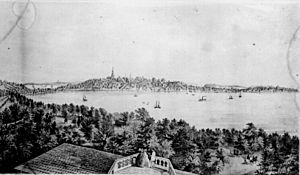
Early Inhabitants
People have lived in the Madison area for about 12,000 years. The Ho-Chunk Native American tribe called this region Teejop, which means "land of the four lakes." They built many effigy mounds (earthworks shaped like animals) for ceremonies and burials over 1,000 years ago.
How Madison Was Founded
Madison began in 1829 when James Duane Doty, a former judge, bought land between Lakes Mendota and Monona. He wanted to build a city there. In 1836, when Wisconsin became a territory, its leaders needed to choose a permanent capital. Doty worked hard to convince them to pick Madison.
He named the city after James Madison, the fourth U.S. President, who had recently passed away. He also named the streets after the people who signed the U.S. Constitution. Even though Madison was just a plan on paper, the leaders chose it as the capital in November 1836. This was because it was located conveniently between growing cities in the east and older towns in the west.
City Growth and Changes
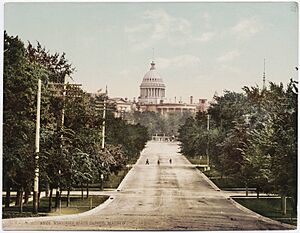
The first stone for the Wisconsin State Capitol building was laid in 1837. The state leaders first met there in 1838. Madison became a village in 1846 and then a city in 1856. When Wisconsin became a state in 1848, Madison remained its capital. The University of Wisconsin–Madison was also started here in 1849.
During the American Civil War, Madison was an important center for the Union Army in Wisconsin. Camp Randall, on the west side of Madison, was used as a training camp and a hospital. After the war, this area became part of the University of Wisconsin.
Modern Times
In 2011, Madison saw large protests against a new law that changed rules for public worker unions. Thousands of people gathered at the capitol for several months.
In 2022, Madison grew bigger by adding most of the nearby Town of Madison. In December 2024, a school shooting happened at Abundant Life Christian School on the east side of the city.
Madison's Geography
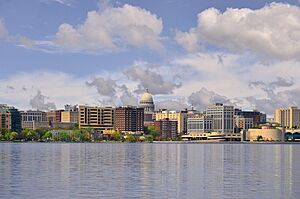
Madison is in the middle of Dane County in southern Wisconsin. It is about 77 miles (124 km) west of Milwaukee and 122 miles (196 km) northwest of Chicago. Downtown Madison is on an isthmus between Lake Mendota and Lake Monona. This unique location is why the city's saying is "Lake, City, Lake."
Madison completely surrounds smaller towns like Maple Bluff, Monona, and Shorewood Hills. It also shares borders with its largest suburb, Sun Prairie, and other towns like Middleton and Fitchburg.
The city is often called "The City of Four Lakes." These are Lake Mendota, Lake Monona, Lake Waubesa, and Lake Kegonsa. While Waubesa and Kegonsa are just south of Madison, Lake Wingra is completely inside the city. All these lakes are connected by the Yahara River.
Neighborhoods of Madison
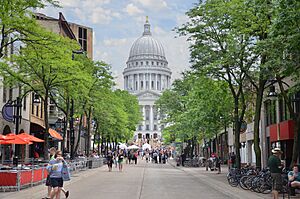
Madison has over 120 official neighborhood groups. Historically, the north, east, and south sides were more for workers, while the west side was for office workers. This is still somewhat true today. Many students live near the University of Wisconsin–Madison campus and downtown.
Capitol Square is the main business area of Madison. It has tall buildings, restaurants, shops, and museums, including the Wisconsin State Capitol. Many public events happen here, like the Dane County Farmers' Market. State Street connects the university campus to Capitol Square. It is a lively area with many places to eat and theaters.
The Marquette neighborhood on the east side is known for its local shops and restaurants. It hosts festivals like the Waterfront Festival and the Willy Street Fair. This area is also known for its colorful houses and murals.
Madison's Climate
Madison has a climate with four distinct seasons. Winters are cold with snow, and temperatures can drop very low. Summers are warm, with average highs in the lower 80s °F (27–28 °C). It rains more in the summer, but winter also gets a good amount of snow.
| Climate data for Madison, Wisconsin (Dane County Regional Airport), 1991–2020 normals, extremes 1869–present | |||||||||||||
|---|---|---|---|---|---|---|---|---|---|---|---|---|---|
| Month | Jan | Feb | Mar | Apr | May | Jun | Jul | Aug | Sep | Oct | Nov | Dec | Year |
| Record high °F (°C) | 58 (14) |
70 (21) |
83 (28) |
94 (34) |
101 (38) |
101 (38) |
107 (42) |
102 (39) |
99 (37) |
90 (32) |
77 (25) |
68 (20) |
107 (42) |
| Mean maximum °F (°C) | 46.2 (7.9) |
51.3 (10.7) |
67.1 (19.5) |
79.1 (26.2) |
85.6 (29.8) |
91.0 (32.8) |
92.2 (33.4) |
90.4 (32.4) |
87.6 (30.9) |
79.4 (26.3) |
63.9 (17.7) |
50.8 (10.4) |
94.1 (34.5) |
| Mean daily maximum °F (°C) | 27.0 (−2.8) |
31.2 (−0.4) |
43.6 (6.4) |
56.9 (13.8) |
69.0 (20.6) |
78.6 (25.9) |
82.1 (27.8) |
79.9 (26.6) |
72.9 (22.7) |
59.6 (15.3) |
44.8 (7.1) |
32.3 (0.2) |
56.5 (13.6) |
| Daily mean °F (°C) | 19.4 (−7.0) |
23.0 (−5.0) |
34.4 (1.3) |
46.3 (7.9) |
58.1 (14.5) |
68.0 (20.0) |
71.9 (22.2) |
69.7 (20.9) |
62.0 (16.7) |
49.7 (9.8) |
36.7 (2.6) |
25.3 (−3.7) |
47.0 (8.3) |
| Mean daily minimum °F (°C) | 11.8 (−11.2) |
14.9 (−9.5) |
25.1 (−3.8) |
35.8 (2.1) |
47.1 (8.4) |
57.4 (14.1) |
61.6 (16.4) |
59.5 (15.3) |
51.0 (10.6) |
39.8 (4.3) |
28.7 (−1.8) |
18.2 (−7.7) |
37.6 (3.1) |
| Mean minimum °F (°C) | −10.6 (−23.7) |
−5.5 (−20.8) |
4.2 (−15.4) |
21.3 (−5.9) |
32.1 (0.1) |
43.2 (6.2) |
49.9 (9.9) |
48.1 (8.9) |
35.8 (2.1) |
25.3 (−3.7) |
12.2 (−11.0) |
−2.6 (−19.2) |
−13.9 (−25.5) |
| Record low °F (°C) | −37 (−38) |
−29 (−34) |
−29 (−34) |
0 (−18) |
19 (−7) |
31 (−1) |
36 (2) |
35 (2) |
25 (−4) |
12 (−11) |
−14 (−26) |
−28 (−33) |
−37 (−38) |
| Average precipitation inches (mm) | 1.47 (37) |
1.52 (39) |
2.26 (57) |
3.78 (96) |
4.10 (104) |
5.28 (134) |
4.51 (115) |
4.16 (106) |
3.43 (87) |
2.77 (70) |
2.22 (56) |
1.63 (41) |
37.13 (943) |
| Average snowfall inches (cm) | 13.7 (35) |
12.8 (33) |
7.0 (18) |
2.6 (6.6) |
0.1 (0.25) |
0.0 (0.0) |
0.0 (0.0) |
0.0 (0.0) |
0.0 (0.0) |
0.6 (1.5) |
3.0 (7.6) |
12.0 (30) |
51.8 (132) |
| Average extreme snow depth inches (cm) | 8.0 (20) |
8.4 (21) |
5.5 (14) |
1.4 (3.6) |
0.1 (0.25) |
0.0 (0.0) |
0.0 (0.0) |
0.0 (0.0) |
0.0 (0.0) |
0.2 (0.51) |
1.4 (3.6) |
6.0 (15) |
10.7 (27) |
| Average precipitation days (≥ 0.01 in) | 10.6 | 9.7 | 10.6 | 12.6 | 12.7 | 11.7 | 10.2 | 9.4 | 9.2 | 10.1 | 9.6 | 10.0 | 126.4 |
| Average snowy days (≥ 0.1 in) | 10.1 | 8.6 | 5.3 | 1.9 | 0.1 | 0.0 | 0.0 | 0.0 | 0.0 | 0.5 | 3.2 | 8.2 | 37.9 |
| Average relative humidity (%) | 74.5 | 73.1 | 71.4 | 66.3 | 65.8 | 68.3 | 71.0 | 74.4 | 76.8 | 73.2 | 76.9 | 78.5 | 72.5 |
| Mean monthly sunshine hours | 143.0 | 152.3 | 187.3 | 206.7 | 263.1 | 293.1 | 304.9 | 270.2 | 213.8 | 172.5 | 111.4 | 109.5 | 2,427.8 |
| Percent possible sunshine | 49 | 52 | 51 | 51 | 58 | 64 | 66 | 63 | 57 | 50 | 38 | 39 | 54 |
| Source: NOAA (relative humidity and sun 1961–1990) | |||||||||||||
People of Madison
| Historical population | |||
|---|---|---|---|
| Census | Pop. | %± | |
| 1840 | 172 | — | |
| 1850 | 1,525 | 786.6% | |
| 1860 | 6,611 | 333.5% | |
| 1870 | 9,176 | 38.8% | |
| 1880 | 10,324 | 12.5% | |
| 1890 | 13,426 | 30.0% | |
| 1900 | 19,164 | 42.7% | |
| 1910 | 25,531 | 33.2% | |
| 1920 | 38,378 | 50.3% | |
| 1930 | 57,899 | 50.9% | |
| 1940 | 67,447 | 16.5% | |
| 1950 | 96,056 | 42.4% | |
| 1960 | 126,706 | 31.9% | |
| 1970 | 171,809 | 35.6% | |
| 1980 | 170,616 | −0.7% | |
| 1990 | 191,262 | 12.1% | |
| 2000 | 208,054 | 8.8% | |
| 2010 | 233,209 | 12.1% | |
| 2020 | 269,840 | 15.7% | |
| 2024 (est.) | 285,300 | 22.3% | |
| U.S. Decennial Census | |||
Population and Diversity
In 2020, Madison had 269,840 people. It was the fastest-growing city in Wisconsin during the 2010s. Madison is the second-largest city in the state.
The city is home to people from many different backgrounds. In 2020, about 71% of the population was White, 9.5% Asian, 7.4% Black or African American, and 8.7% Hispanic or Latino.
Madison also has a notable Hmong community, with about 1,985 people of Hmong background living there in 2022.
Madison's Metro Area
The Madison metropolitan area includes Dane County and nearby counties like Columbia and Green. In 2020, this larger area had over 680,000 people.
Religious Groups
Madison is home to many different religious groups. It is the main city for the Roman Catholic Diocese of Madison. Many Christian churches are present, including Lutheran, Baptist, and others.
The city also has Sikh Gurdwaras, Hindu temples, mosques, and synagogues. The Gates of Heaven Synagogue is one of the oldest surviving synagogue buildings in the U.S. Madison is also home to the Freedom from Religion Foundation, which supports the idea of keeping government and religion separate.
Madison's Economy
Madison's economy is strong in government, education, technology, and healthcare. It also has businesses related to farming and manufacturing. Many companies choose Madison because of its highly educated workforce.
The University of Wisconsin–Madison and the Wisconsin state government are the biggest employers. Epic Systems, a healthcare software company, is the largest private employer. Madison also has many financial companies, like American Family Insurance.
Government and Education
Since Madison is the capital, it has many state government offices. It also has federal offices and groups that work with the government.
The University of Wisconsin–Madison is a major research university. It employs over 25,000 people and is the main campus of the University of Wisconsin System.
Technology and Health
Madison is a big center for biotech and health technology. Companies like Exact Sciences and Promega are based here. Many other health and tech companies have offices in the city.
University of Wisconsin Hospital and Clinics is an important hospital for the region. It is known for its work in transplants and cancer care. Other hospitals in Madison include St. Mary's Hospital.
Arts and Culture
Attractions and Museums
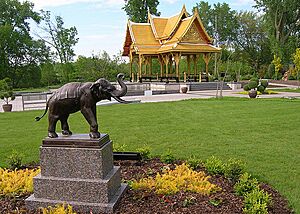
The Memorial Union is a popular spot on Lake Mendota. Its outdoor terrace has unique "sunburst" chairs that are a symbol of the city. The Union hosts concerts and has restaurants.
The Henry Vilas Zoo is a 28-acre (0.11 km²) public zoo. It is one of the few free zoos in North America and gets over 750,000 visitors each year.
Olbrich Botanical Gardens has 16 acres (0.06 km²) of outdoor gardens and a large indoor conservatory. A special feature is the Thai sala, a gift from Thailand.
Art museums include the Chazen Museum of Art and the Madison Museum of Contemporary Art. Other museums are the Wisconsin Historical Museum and the Madison Children's Museum.
Architecture in Madison
Madison has many interesting buildings. The Wisconsin State Capitol building is a beautiful landmark. The Monona Terrace convention center was designed by Frank Lloyd Wright.
The height of buildings in downtown Madison is limited by a state law. This rule helps keep the view of the State Capitol building clear from most parts of the city.
Frank Lloyd Wright, a famous architect from Wisconsin, designed eight buildings in Madison. His first Usonian house, the Herbert and Katherine Jacobs First House, is a UNESCO World Heritage Site.
Food and Dining
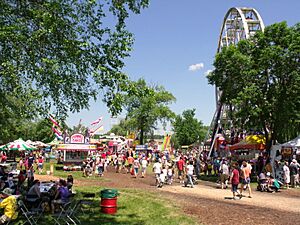
Madison's food scene is influenced by its farms and diverse history. Dairy products, like cheese curds, are very popular. Many bakeries sell hot and spicy cheese bread.
The Dane County Farmers' Market is held around Capitol Square on Saturdays. It is the largest market in the country where only local producers sell their goods. Madison also has many restaurants that use fresh, local ingredients.
The city is home to the World's Largest Brat Fest, which sells over 200,000 bratwurst sausages each Memorial Day weekend. The Great Taste of the Midwest is a popular craft beer festival held in August.
Music Scene
Madison has a lively music scene. Many places offer live music every night, from small coffee shops to larger venues like the Overture Center. In the summer, the Memorial Union Terrace has live music five nights a week.
Madison hosts many music festivals in the summer. Concerts on the Square is a weekly event where the Wisconsin Chamber Orchestra performs free concerts on the capitol's lawn. Other festivals include the Waterfront Festival and the Willy Street Fair.
The Madison Scouts Drum and Bugle Corps is a competitive group that performs across North America. The University of Wisconsin Marching Band also performs at local events.
Performing Arts
The Overture Center for the Arts is home to groups like the Madison Opera and the Madison Symphony Orchestra. The Bartell Theatre hosts many smaller theater companies.
Madison also has comedy clubs and improv groups. The Wisconsin Center for Film and Theater Research in Madison has a large collection of entertainment history.
Sports in Madison
Most of Madison's major sports are linked to the University of Wisconsin–Madison. Their teams, called the Wisconsin Badgers, compete in NCAA Division I. The Wisconsin Badgers football team plays at Camp Randall Stadium, which can hold up to 83,000 fans. The men's basketball and ice hockey teams play at the Kohl Center.
Forward Madison FC is Madison's professional soccer team, started in 2018. They play at Breese Stevens Field. A professional women's soccer team will also join the USL Super League in 2025. Other professional teams include the Madison Radicals (ultimate frisbee) and LOVB Madison (volleyball).
The Madison Capitols are a junior ice hockey team. The Madison Mallards are a college summer baseball team that plays at Warner Park.
Amateur Sports
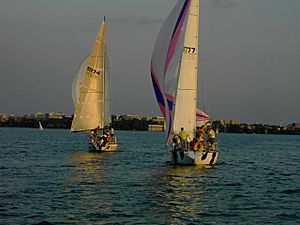
Madison hosts several endurance races, like the Crazylegs Classic and Ironman Wisconsin. The CrossFit Games were held at the Alliant Energy Center from 2017 to 2023.
The city has active ultimate disc leagues. The Wisconsin Rugby Club and the Madison Curling Club are also popular. The Blackhawk Ski Club, formed in 1947, has produced Olympic ski jumpers.
Parks and Outdoor Fun
Madison has over 6,431 acres (26 km²) of park space. Parks include James Madison Park with lake views and Warner Park, home to the Madison Mallards baseball team. Goodman Pool is the city's public outdoor swimming pool.
The University of Wisconsin–Madison Arboretum protects forests and prairies. The Lakeshore Nature Preserve also helps preserve native plants and animals along Lake Mendota.
In winter, people enjoy ice skating, ice hockey, cross-country skiing, and ice boating. In warmer months, popular activities include sailing, bicycling, and hiking.
Madison is known for its many bike paths and lanes. It was named a platinum-level Bicycle Friendly Community in 2015, one of the highest honors for bike-friendly cities in the U.S.
City Government
Madison voters usually support the Democratic Party in national elections. The city council often has a majority of liberal and progressive members.
Madison is considered a very liberal and progressive city in Wisconsin. For example, in 2006, most Madison voters voted against a state law to ban gay marriage, even though the ban passed statewide.
Madison has a mayor-council government. The city council has 20 members, one from each district. The mayor is chosen by a citywide vote.
Madison is part of Wisconsin's 2nd congressional district in the United States House of Representatives.
Education in Madison
The Madison Metropolitan School District serves the city's public schools. It is the second-largest school district in Wisconsin, with about 25,000 students in 46 schools. Madison has five public high schools: Vel Phillips Memorial, Madison West, Madison East, La Follette, and Malcolm Shabazz City High School.
Madison is home to the main campus of the University of Wisconsin, Edgewood College, and Madison Area Technical College. This means nearly 65,000 college students live in the city. The University of Wisconsin alone has about 50,000 students.
Media in Madison
Print Media
Madison has many newspapers and magazines. The Wisconsin State Journal is a morning newspaper. The Capital Times is published online daily and has two print editions a week. These two papers are run together as Capital Newspapers.
Isthmus is a free weekly newspaper. The Onion, a satirical news publication, started in Madison in 1988 before moving to New York. The university has two student newspapers: The Daily Cardinal and The Badger Herald.
The Progressive magazine, which focuses on politics, has been published in Madison since 1909.
Radio Stations
Madison has many radio stations. Some are owned by large companies, while others are local. Mid-West Family Broadcasting is a company based in Madison that owns radio stations across the Midwest.
Madison also has two community radio stations run by volunteers: WORT (89.9 FM) and WSUM (91.7 FM). WSUM is run by students. WHA is Madison's Wisconsin Public Radio station, one of the first radio stations in the U.S.
TV Stations
Madison has several TV stations, including commercial and public channels. These include WISC-TV (CBS), WMTV (NBC), WKOW-TV (ABC), and WMSN-TV (Fox). WHA-TV is a public television station owned by the University of Wisconsin. The Madison City Channel covers city government events.
City Services
Transportation
Madison is served by the Dane County Regional Airport, which handles about 2.2 million passengers each year. Metro Transit runs bus routes throughout the city and to some nearby suburbs.
Madison is known for being very bike-friendly. About 5.3% of working residents rode their bikes to work in 2014. The city has many bike paths and lanes.
Buses and Public Transit
Metro Transit is Madison's public bus system. It started its first bus rapid transit line in 2024.
Regional buses connect Madison to other major cities. Companies like Badger Bus and Greyhound Lines offer routes to places like Milwaukee, Chicago, and Minneapolis.
Highways
Major highways like Interstate 39, I-90, and I-94 run along the east side of Madison. These connect the city to other parts of Wisconsin and nearby states.
US 12, also called the Beltline, is a large highway that goes around the south and west sides of Madison.
Railways
Freight train services are provided by the Wisconsin and Southern Railroad and Canadian Pacific Kansas City. While there is no passenger train service directly in Madison, Amtrak offers bus connections to train stations in Milwaukee and Chicago.
Plans to bring Amtrak passenger train service back to Madison were discussed in 2021. The city held meetings in 2024 to consider possible locations for a new train station.
Public Safety
Fire Department
The Madison Fire Department (MFD) provides fire protection and emergency medical services. It operates from 14 fire stations with many vehicles, including fire engines, ladders, and ambulances. The MFD also helps nearby communities. In 2021, MFD started a special team with mental health professionals to respond to mental health emergencies.
Police Department
The Madison Police Department is the law enforcement agency for the city. It has six districts and special units like the K9 Unit and Crime Scene Unit.
In 2015, an incident involving an officer and an unarmed man, Tony Robinson, led to public discussion. The shooting was investigated by the Wisconsin Department of Justice. The district attorney later determined the shooting was justified self-defense.
Famous People from Madison
Madison's Nicknames
Madison has several nicknames, including:
- Mad City
- Madtown
- The Berkeley of the Midwest
- Four Lakes City
- People's Republic of Madison
Sister Cities
Madison has sister city relationships with several cities around the world:
 Arcatao, El Salvador (1986)
Arcatao, El Salvador (1986) Bahir Dar, Ethiopia (2019)
Bahir Dar, Ethiopia (2019) Camagüey, Cuba (1994)
Camagüey, Cuba (1994) Freiburg im Breisgau, Germany (1988)
Freiburg im Breisgau, Germany (1988) Kanifing, Gambia (2016)
Kanifing, Gambia (2016) Mantua, Italy (2001)
Mantua, Italy (2001) Obihiro, Japan (2003)
Obihiro, Japan (2003) Tepatitlán de Morelos, Mexico (2012)
Tepatitlán de Morelos, Mexico (2012) Vilnius, Lithuania (1988)
Vilnius, Lithuania (1988)
Images for kids
See also
 In Spanish: Madison (Wisconsin) para niños
In Spanish: Madison (Wisconsin) para niños


